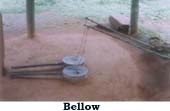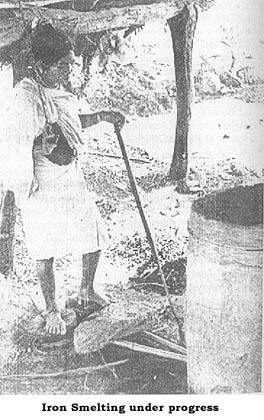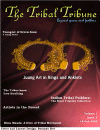Tribes knew Iron Smelting
The technology of iron smelting was introduced in India after the copper-bronze age, of Indus Valley civilisation. Since that time the traditional iron smelting technology was continuing till the mid part of the twentieth century and gradually became extinct. The tribes like Asur, Agaria, Kol, Cheeroo and Kharia were some of the primitive iron smelters of central and eastern India. These tribal people live in the dense hill and plateau region close to the source of the raw materials. They smelted iron not only to fulfill their needs but also to meet the requirements of the neighbours.
Ore
Charcoal was used for firing the furnace. Furnace was either dug in the ground or made like a hearth. The charcoal was prepared by burning wood in a pit covered by leaves and sand. Good varieties of charcoal were made by burning log of valuable timber quality like Sal (Shorea Robusta). Strict forest rules, however, made the availability of Sal difficult and this forced the tribal smelters to abandon the indigenous form of smelting.
These iron smelters lived in dense forests rich with iron ore for easy availability of raw materials. After practicing the method for nearly four thousand years they could not pursue any further. Both Verrier Elwin and Leuva observed the death of the practice in early twentieth century among the Agaria and the Asur. The causes of the demise of such practice could be (i) the establishment of modern technology based iron smelting plant at Tata Nagar and Burnpur, (ii) restriction on forest tree felling, (iii) labour intensive process of antique smelting and (iv) the growing reluctance amongst the concerned tribes to pursue the practice, due to the spread of education. Further constant market failure could not sustain the old age technique.
|
References:
- Banarjee, N.R. 1965.The Iron Age in India. Delhi: Munshiram Monoharlal.
- Chakrabarti, D.k. 1992 The Early Use of Iron in India. Delhi: Oxford University Press.
- Elwin, V. 1942. The Agaria: Humphrey Milford: Oxford University Press.
- Forbes,R.J. 1972. Studies in Ancient Metallurgy. Leiden: E.J. Brill.
- Leuva, K.K. 1963. The Asur: A Study of the Primitive Iron Smelters. New Delhi: Bharatiya adimjti sevak Samaj.
- Mohanta, B.K 2002 Neolithic and Post-Neolithic Cultures of Northern Orissa (With special references to Mayurbhanj and Keonjhar districts), Unpublished Ph.D Thesis. Bhubaneswar: Utkal University.
- Mohanta, B.K., Basa K.K, Chattopadhayay and Das T.K., 2003, "Pre-industrial iron smelting in Mayurbhanj, Northern Orissa" an ethno-historic study. man and Environment XXVIII(2):81-90
- Sarkar, S. 1997. From Agaria to Lohar: Blacksmith in the Tribal Society of (donia) Eastern India. Journal the Indian Anthropological Society 32:39-154
- Tripathy, V and A. K. Mishra 1997. Understanding Iron Technology: An Ethnographic Model, Man and Environment XXII(1):59-67
- Tylecote, R. F. 1965. Iron Smelting in Pre Industrial Communities, Journal of Iron and Steel Institute 203(4): 340-348
Source: Photographs
All Photographs are by the author







